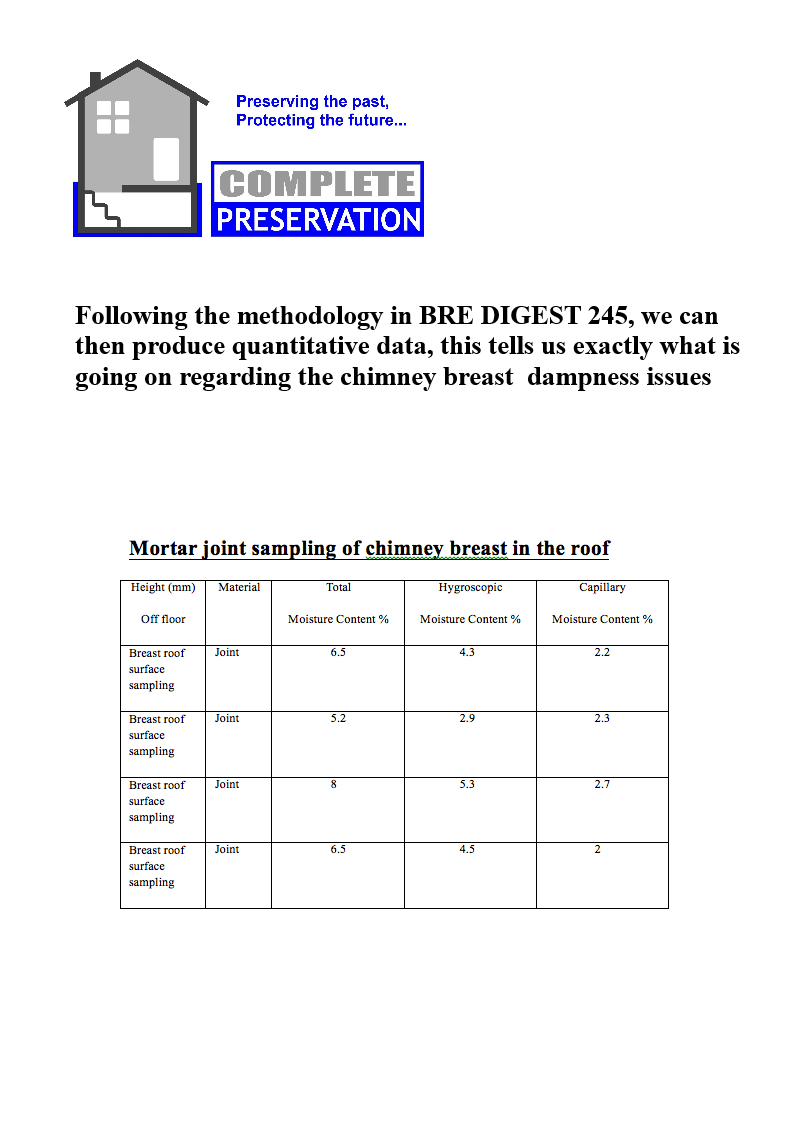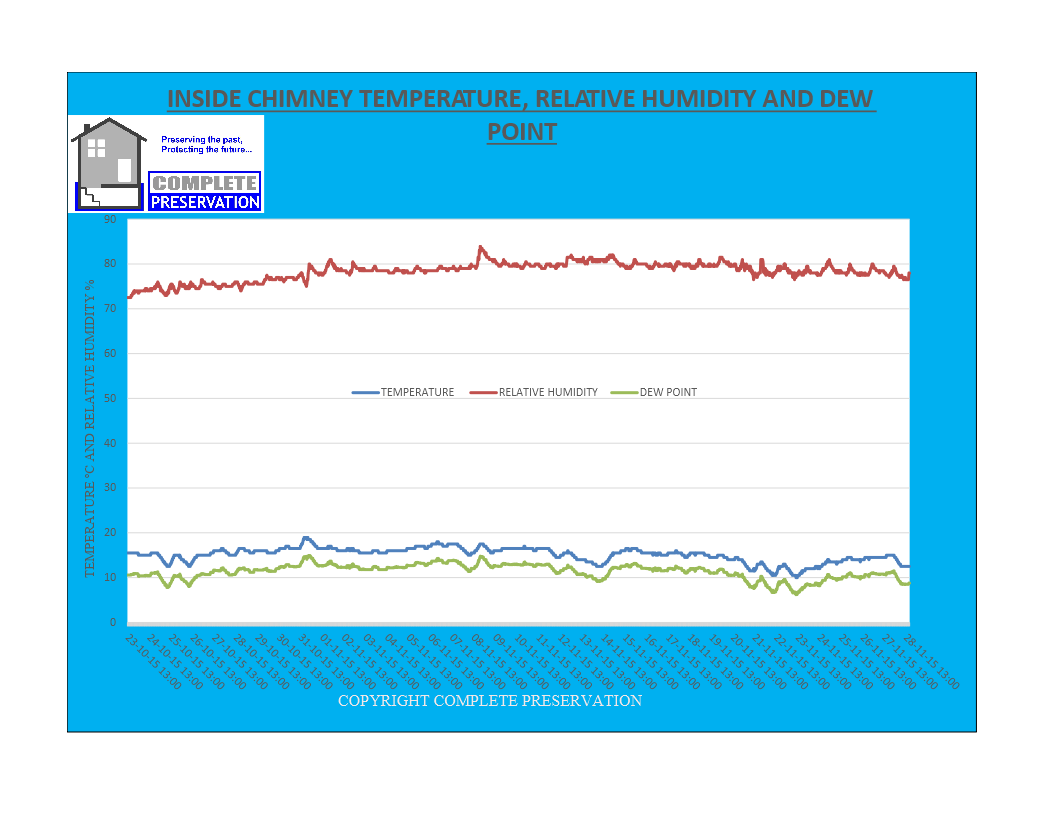Complete Preservation are specialists when it comes to chimney dampness investigations, when I say this it’s because it’s what we do every week. We follow ‘damp specialists’ around, roofers, builders the lot. Chimney dampness is very difficult to get right, you speak to a roofer they say it’s a leak, you speak to a builder, they say it’s a leak, you speak to some damp specialists and they will tell you it’s hygroscopic salts………There is never any proper analysis carried out, it’s just presuming. Well this had lots of presuming just like the others I visit on a weekly basis where they have often spent thousands of pounds and they still have issues!
Below is some pictures of a recent survey, this property has had everything done to it to try and fix the damp issue on the chimney and adjacent walls. The external gable wall has been re-pointed with cement, it had been waterproofed with an external waterproofing product, chimney has been ventilated, ventilation has then been sealed up, specialist salt resistant re-plastering has also been carried out internally……and there is still damp patches on the chimney breast which get worse in the winter months.
Damp problems on chimney breasts are a completely different kettle of fish when it comes to diagnosis, there is no way possible that you can actually diagnose if there is a small amount of free moisture in the wall with a damp meter, damp meters generally measure resistance, 1.5 % of hygroscopic moisture content if hygroscopic salts are present even if the wall is bone dry will give a reading on my protimeter of around 25 wme, this is considered a high reading, or should we say something is going on to make it read this figure! So we get 25 wme on our damp meter is this hygroscopic salt or damp from penetrating damp? It’s impossible to say! Some independent damp specialists I have even known to use a speedy meter, also known as a carbide meter, these are an absolute complete waste of time to diagnose any kind of damp on site when there is potentially hygroscopic salts in the sample on site. This is because they can’t differentiate between free moisture (damp) and hygroscopic salts, when the pressure goes up in the speedy meter it will only tell you the total moisture content, this being the sum of the free moisture and hygroscopic moisture content. This is well documented in BRE DIGEST 245, THESE SPEEDY METERS CAN’T DIAGNOSE RISING DAMP OR ANY DAMP WHEN THERE IS POTENTIALLY HYGROSCOPIC SALTS PRESENT IN THE SAMPLE ON SITE.
The only way to tell if there is free moisture in the sample is to follow the laboratory methodology in BRE DIGEST 245, this will seperate the free moisture and hygroscopic moisture content. This involves laboratory analysis, we carry this out using excel spreadsheets to produce the results which we then put in a table of results indicating where the sample was taken.
In the below picture you can see the damp patch – stain on the chimney breast and the adjacent wall. Readings from between 24% wme to 54% wme were taken across the damp stains, the rest of the breast just gave the readings you would expect from a dry wall.
It is also an advantage to carry out an aerial view of the chimney looking for any obvious defects. Note the re-pointing that has been carried out.
This is the view of the chimney in the roof and the gable wall, there is clear dark staining to the breast.
A data logger was installed along with a k probe to measure the surface temperature of the breast, a data logger was also put in the roof to measure the relative humidity, air temperature, dew point and vapour pressure.
The bottom picture in the image shows that the surface temperature was only 3.5 degrees above dew point.
Just for my own research I installed a data logger up the chimney to take readings, this was on my my telescopic carp rod…..luckily I wasn’t off fishing 🙂
Data loggers were placed around the property where I thought necessary , and most importantly an external data logger, this is all then downloaded after a couple of weeks and put into a specialist excel data dump spreadsheet, we can then make many graphs. One point I will make, if you don’t use a surface temperature logger you can’t prove the surface has gone into condensation, you also need an external data logger to show the differential vapour pressure between external and the internal environment, this being the internal vapour pressure is the sum of the external vapour pressure and the internal vapour pressure. Me and my peer group have found differential vapour pressures of 0.5 kPa difference can be indicative of ventilation issues in buildings.
72,000 measurements were taken with our data loggers, this may sound ridiculous but it’s easy, the loggers we have programmed to take a reading every half an hour. Data is king, using this data we can now produce many graphs in our excel spreadsheet, for this survey I produced 12 graphs, some of which isn’t necessary but it gives me a better understanding of how moisture moves through the building.
The below graph shows the temperature, dew point, and relative humidity of inside the chimney.
The below graph is the game changer this actually shows the surface temperature and dew point meeting, this proves the chimney hits dew point in the roof and condensation is occurring on the chimney breast. 
Below is the table of results, as there were many samples taken I have only shown the samples which were wet, all the others were dry.
 The samples taken were near the surface of the lime mortar joint, and also deeper into the wall by inserting a 10mm tube, this ensured there was no contamination of sample drillings that could make surface samples appear the same as samples taken within the wall. Free moisture was found in surface samples but not at depth indicating along with our graphs the issue was condensation forming on the chimney breast, this then subsequently ran down the wall and contaminated the chimney in the bedroom and adjacent walls. We now know the cause of the issue, I could then write a specification of repair to include ventilation to ensure this problem will not come back.
The samples taken were near the surface of the lime mortar joint, and also deeper into the wall by inserting a 10mm tube, this ensured there was no contamination of sample drillings that could make surface samples appear the same as samples taken within the wall. Free moisture was found in surface samples but not at depth indicating along with our graphs the issue was condensation forming on the chimney breast, this then subsequently ran down the wall and contaminated the chimney in the bedroom and adjacent walls. We now know the cause of the issue, I could then write a specification of repair to include ventilation to ensure this problem will not come back.
The below link is of another interesting survey regarding a damp chimney https://blog.completepreservation.co.uk/2014/06/02/the-damp-stains-on-the-chimney-breast-is-it-salt-damp-or-a-leak/
Samples can also be sent by post if you wish, I charge £60 per sample including vat.
I was very fortunate to be trained on this subject by a good friend of mine Graham Coleman, without him damp diagnosis would never be this involved and I would still be struggling. Graham Coleman is regarded as the “expert” in dampness and fungal decay in the UK, he is a Consultant that is a specialist in expert witness work, he can be contacted at www.buildingpreservation.com with over 40 years experience he really knows his onions.
Graham has also taught another good friend of mine Bryan Hindle how to carry out this type of survey, Bryan is regarded as the leading dampness contractor in the UK, he offers similar services to my small company, Bryan can be contacted at www.btpreservation.co.uk he is based in Leeds.
To my knowledge there are very few people that offer laboratory analysis and full data logging for complete diagnosis, and between us we cover the whole of England.
Follow us on our social channels where you can get free tips on damp and building defect issues, and you can engage and get your questions answered.
TicTok
TikTokhttps://www.tiktok.com › @complet…Complete Preservation (@complete_preservation)
YouTube
https://youtube.com/@completepreservation
https://instagram.com/complete_preservation?igshid=OGQ5ZDc2ODk2ZA==
https://www.linkedin.com/in/ross-charters-85883b52
https://www.facebook.com/complete.preservation/?locale=en_GB







This is very interesting, I’m more confused though now as I thought my damp was from a leak in the lead. I think I need to book a survey please, also can you do a rising damp -damp proofing survey please in Trowbridge? How do I book this in please?
Hi Belinda, yes we offer rising damp surveys in Trowbridge. Please can you email me your contact number so I can discuss with you the issues you have. Then I can advise what type of survey you possibly need. My email is enquiries@completepreservation.co.uk
excellent research Ross, very interesting
Thanks Paul, I have another one that is very interesting……When I eventually finish it I will send you a link 🙂
[…] Why is there a damp patch and staining on my chimney breast? […]
[…] For more on the cutting edge damp diagnosis PCA members are involved in try my good friend Ross Charters’ blog – https://blog.completepreservation.co.uk/2016/04/07/why-is-there-a-damp-patch-and-staining-on-my-chim… […]